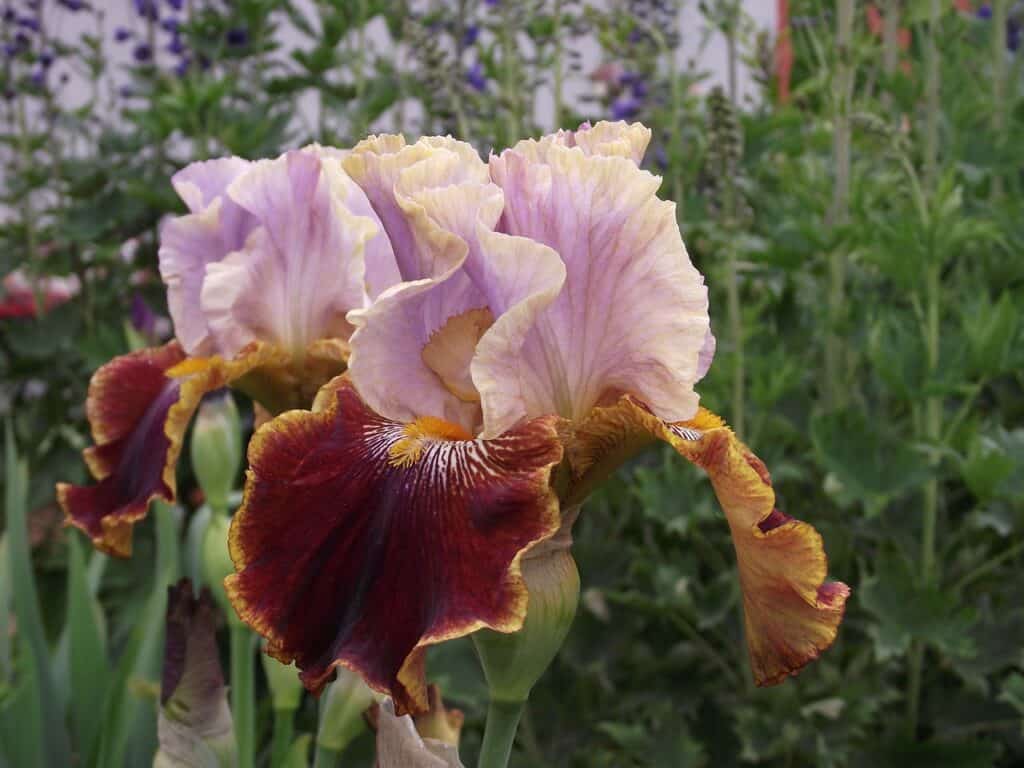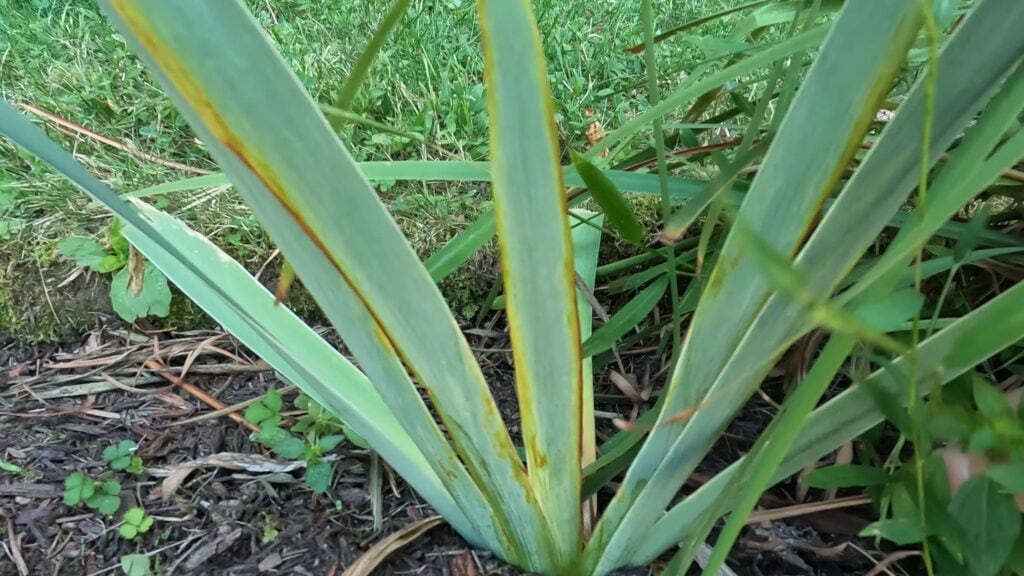Bearded Irises (Iris x germanica) are beautiful, low-maintenance, flowering perennials. Of all the iris varieties, the Bearded iris is the most sought-after variety known for its prized flowers. Once your Bearded irises are established, you will be rewarded with gorgeous flowers year after year even if you don’t do anything- perfect for the lazy gardener.

Just make sure your Bearded Irises are planted in a sunny location and they will automatically flower beautifully. The only thing you have to do is to cut back irises in the Fall to prepare it for the following year. Do know Bearded irises are prone to Iris borers, which are pests that infest the rhizomes, just keep an eye for it and you should be able to manage it. Here is a beginner’s guide on how to care for your Bearded Irises.
Bearded Irises Planting Basics
| Name | Bearded Irises |
| Botanical Name | Iris x germanica |
| Flower Color | Many Colors- Purple, Pink, Yellow, Blue, White, Orange |
| Height | 8-36 inches |
| Sun | Full Sun |
| Soil | Moist, Well-Drained |
| Bloom Time | Early summer |
| Zones | 3-10 |
| Plant Depth | Plant just below the surface of the ground |
| Plant Spacing | 12 to 24 inches apart |
| Toxic to Cats and Dogs | Toxic |
How to Grow Irises Video
Bearded Irises (Iris x germanica): Size
Bearded Irises grow to 8-36 inches tall.
Planting Your Bearded Irises
Where to Plant Bearded Irises (Iris x germanica)
Irises are best planted in sunny locations receiving at least 6-8 hours of sunlight per day. They prefer moist, well-drained soil.
| Sun | Full Sun |
| Soil | Moist, Well-Drained |
How Deep Should You Plant Bearded Irises?
According to the American Iris Society, you should plant your rhizomes at or just barely below the surface of the ground. Irises should be planted so the tops of the rhizomes are visible and the roots are spread out facing downwards in the soil.
However, in extremely hot climates or with very light soils, cover rhizomes with up to one inch of soil. Tamp the soil firmly to anchor the rhizomes until new roots begin to grow, and water well. It is a common mistake to plant Irises too deeply.
How to Plant Bearded Irises
Bearded irises should not be planted too deeply. Dig a hole just deep enough to cover the rhizome. Make sure you dig a wide enough hole so you can spread out the roots. Center the rhizome in the hole and spread out the roots. Cover it with soil. Water thoroughly after planting. Keep the soil moist until roots are established. Use a bulb planter tool to make planting your bulbs easier.
When is the Best Time to Plant Bearded Irises?
The best time to plant Bearded iris is in July, August or September. Make sure you plant your Bearded iris 4-6 weeks before the first frost to give it sufficient to grow new roots for winter.
Dividing Bearded Irises
How Often do you need to Bearded Divide Irises?
Bearded irises will suffer from overcrowding and will need to be divided every 3-4 years.
How to Divide Bearded Irises
Water the Bearded iris you will be dividing (or divide after rain). It’s easier to divide when the soil is moist. With a shovel, divide Bearded irises by digging up the entire Iris exposing the roots and rhizomes. Use scissors and a shovel to cut up the Bearded iris clump into several divisions. Plant each Bearded iris division in a sunny location with well-drained soil. Water thoroughly. Keep up with the watering until the roots are established.
Check out my article and video for a step-by-step guide on How to Divide Irises
Propagating Your Bearded Irises
How to Propagate Bearded Irises Iris x germanica
The best way to propagate Bearded irises is by division. Water the iris you will be dividing (or divide after rain). With a shovel, divide irises by digging up the entire Iris exposing the roots and rhizomes. Use scissors and a shovel to cut up the iris clump into several divisions. Plant each division in a sunny location with well-drained soil. Water thoroughly. Keep up with the watering until the roots are established.
Care for Your Bearded Irises
Do You Need to Water Your Bearded Irises every day?
Established Bearded irises don’t need to be watered frequently. Check the soil, stick your finger in the soil 3 inches deep, if it feels dry then you can water it. However, it’s best to underwater than overwater Bearded irises. Newly planted Bearded irises will need to be watered to ensure sufficient root growth. Water newly planted Bearded irises at least 3x a week.
Do You Need to Deadhead Bearded Irises After They Bloom?
Bearded irises don’t need deadheading after bloom. The only time you’d want to deadhead Bearded irises is if you have a rebloomer or if you want to tidy up your irises by removing the dead flowers. Although, know that there is no guarantee that irises that are sold as rebloomers will rebloom after deadheading.
What to Do with Your Bearded Irises After They Bloom?
Bearded irises don’t need deadheading. Just leave your Bearded irises alone after they bloom. Keep the leaves of your Bearded iris intact since it’s vital for the leaves to continue photosynthesizing even after they bloom so it will continue to feed the iris rhizome.

How Often Should You Fertilize Your Bearded Irises?
Fertilize your Bearded irises once in the Spring and one month after bloom.
What Fertilizer Should You Use on Your Bearded Irises?
Use a balanced fertilizer on your Bearded irises.
Troubleshooting Your Bearded Irises
Are Bearded Irises Deer Resistant?
Bearded irises are deer-resistant plants. I’ve had Bearded irises in my garden for years now and I’ve never had any problems with deer. I also find that squirrels and rabbits will not bother your Bearded irises. Trust me, I get plenty of deer, squirrels and rabbits in my garden. I plant Bearded irises freely without any worry of garden critters.
Are Bearded Irises Toxic to Dogs and Cats?
Bearded irises are toxic to dogs and cats. According to the ASPCA, Irises contain Pentacylic terpenoids (zeorin, missourin and missouriensin) which are toxic to dogs and cats. It can cause vomiting and diarrhea. Iris rhizomes contain the highest level of Pentacylic terpenoids.
What are the common problems of your Bearded Irises?
Bearded irises are commonly afflicted by Iris borers which is a pest that tunnels in the rhizomes. If you see brown leaf tips and dying leaves, it can be a sign of iris borers. Remove the affected leaves and dig out the rhizomes to see if there are tunnels and caterpillars. If you see these, get rid of the infected rhizomes.
Iris borers typically affect irises planted in the East and Midwest. According to the American Iris Society, there have been no reports of Iris Borer west of the Rocky Mountains.
Preparing Your Bearded Irises for Winter
How Should You Prepare Your Bearded Irises for Winter?
To prepare Bearded irises for winter, cut back Bearded irises in the Fall by removing the stems and leaves. Cut your Bearded irises down so that only around 2 inches of foliage are left.
Wait until after 3-4 frosts when the iris leaves have completely died off before cutting back Bearded irises. It’s important that you leave the leaves of your Bearded irises intact for a few weeks after the bloom dies so it can deliver much-needed energy to the rhizomes for next year.
Check out my article and video for the step-by-step guide on how to cut back irises
You May Also Be Interested in These Iris Plant Care Guide
Beginner’s Guide: How to Divide Irises (video)
